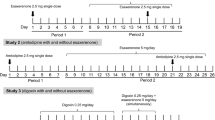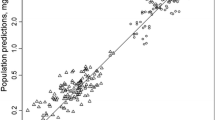Summary
The trough concentration-dose (C/D) ratio of flecainide was prospectively studied in 78 patients with various cardiac arrhythmias. After the removal of two outlier values, no influence of body weight on C/D ratio was evidenced. Coadministration of amiodarone, and, moreover, the presence of heart failure increase the C/D ratio, from 2.01±0.78 to 2.55±0.37 and 2.9±1.19 ng/ml/mg, respectively (p<0.001 by two-factor analysis of variance). The presence of both heart failure and amiodarone therapy increases the C/D ratio to 3.88±1.07 ng/ml/mg.
A single loading oral dose (30 mg/kg) of amiodarone increased C/D measured at the sixth hour in nine patients from 2.27±0.50 to 2.57±0.73 ng/ml/mg (p<0.05). The trough C/D ratio increased more during chronic treatment from 2.03±0.86 to 2.92±1.32 ng/ml/mg (p<0.05).
Thus, a dosage reduction of flecainide (of 50% in some cases) is mandatory, in case of heart failure or the combination with amiodarone therapy, to obtain a plasma level of the drug that is similar to those observed in patients with a normal heart and without amiodarone therapy. The flecainideamiodarone interaction seems time dependent.
Similar content being viewed by others

References
Duff HJ, Roden DM, Maffucci RJ, et al. Suppression of resistant ventricular arrhythmias by twice daily dosing with flecainide.Am J Cardiol 1981;48:1133–1140.
Flecainide-quinidine research group. Flecainide versus quinidine for treatment of chronic ventricular arrhythmias. A multicenter clinical trial.Circulation 1983;67:1117–1123.
Kjekshus J, Bathen J, Orning OM, Storstein L. A doubleblind crossover comparison of flecainide acetate and disopyramide phosphate in the treatment of ventricular premature complexes.Am J Cardiol 1984;53:72B-78B.
Clementy J, Dallocchio M, Bricaud H. Etude comparée de l'activité d'une quinidine retard et du flécaïnide dans le traitement des extrasystoles.Med Hyg 1982;40:4553–4559.
Leclercq JF, Coumel P. Le flécaïnide, un nouvel antiarythmique.Arch Mal Coeur 1983;76:347–355.
Lal R, Chapman PD, Naccarelli GV, et al. Short- and longterm experience with flecainide acetate in the management of refractory life-threatening ventricular arrhythmias.J Am Coll Cardiol 1985;6:772–779.
Platia EV, Estes NAM, Heine DL, et al. Flecainide: Electrophysiologic and antiarrhythmic properties in refractory ventricular tachycardia.Am J Cardiol 1985;55:956–962.
Nathan A, Hellestrand KJ, Bexton RS, et al. Proarrhythmic effects of the new antiarrhythmic agent flecainide acetate.Am Heart J 1984;107:222–228.
Leclercq JF, Maisonblanche P, Cauchemez B, Coumel P. Respective role of sympathetic tone and of cardiac pauses in the genesis of 62 cases of ventricular fibrillation recorded during Holter monitoring.Eur Heart J 1988;9:1276–1283.
Chouty F, Funck-Brentano C, Landau JM, Lardoux H. Efficacité de fortes doses, de lactate molaire par voie veineuse lors des intoxications au flecaïnide.Presse Méd 1987;16:808–810.
CAST investigators. Preliminary report: Effect of encainide and flecainide on mortality in a randomized trial of arrhythmia suppression after myocardial infarction.N Engl J Med 1989;321:406–412.
Escoubet B, Coumel P, Poirier JM, et al. Suppression of arrhythmias within hours after a single oral dose of amiodarone and relation to plasma and myocardial concentration.Am J Cardiol 1985;55:696–702.
Conard GJ, Ober RE. Metabolism of flecainide.Am J Cardiol 1984;53:41B-51B.
Conard GJ, Carlson GL, Frost JW, Ober RE. Human plasma pharmacokinetics of flecainide acetate, a new antiarrhythmic, following single oral and intravenous doses.Clin Pharmacolol Ther 1979;25:218–222.
Mikua G, Gross AS, Beckmann J, et al. The influence of the sparteine/debrisoquine phenotype on the disposition of flecainide.Clin Pharmacol Ther 1989;45:562–7.
Woosley RL, Siddoway LA, Duff HJ, Roden DM. Flecainide dose-response relations in stable ventricular arrhythmias.Am J Cardiol 1984;53:59B-65B.
Lewis GP, Holtzman JL: Interaction of flecainide with digoxin and propranolol.Am J Cardiol 1984;53:52B-57B.
Author information
Authors and Affiliations
Rights and permissions
About this article
Cite this article
Leclercq, J.F., Denjoy, I., Mentre, F. et al. Flecainide acetate dose-concentration relationship in cardiac arrhythmias: Influence of heart failure and amiodarone. Cardiovasc Drug Ther 4, 1161–1165 (1990). https://doi.org/10.1007/BF01856514
Issue Date:
DOI: https://doi.org/10.1007/BF01856514



